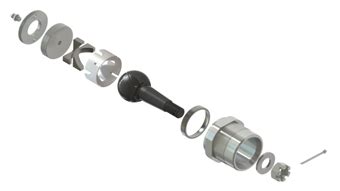Ball Joint Replacement: Frequently Asked Questions
Ball joints are critical components in your vehicle's suspension system, connecting the control arms to the steering knuckles. They allow for smooth steering and suspension movement. When they wear out, however, you'll experience problems like clunking noises, wandering steering, and uneven tire wear. Replacing a ball joint is a significant repair, so it's natural to have questions. This comprehensive guide addresses common concerns surrounding ball joint replacement.
What are the signs that I need a ball joint replacement?
Several telltale signs indicate that your ball joints might be worn out and require replacement. These include:
- Clunking or popping noises: Especially when turning or going over bumps, these sounds often signify a failing ball joint. The noise is caused by the joint's internal components moving abnormally.
- Wobbly steering wheel: Difficulty maintaining a straight line while driving or a loose feeling in the steering wheel suggests a potential problem with your ball joints.
- Uneven tire wear: Premature or irregular tire wear can be caused by misaligned wheels, a common consequence of worn-out ball joints. Inspect your tires regularly for unusual wear patterns.
- Visible damage: If you notice any visible damage to the ball joint boot (the rubber covering), it's a strong indicator of internal damage and the need for replacement. A torn boot exposes the internal components to dirt and debris, leading to premature failure.
- Vehicle pulls to one side: A consistent pull to one side while driving may indicate a problem with the ball joints, especially if it's accompanied by other symptoms.
How much does a ball joint replacement cost?
The cost of a ball joint replacement varies significantly based on several factors:
- Vehicle make and model: Some vehicles are more complex to work on than others, affecting labor costs.
- Number of ball joints needing replacement: Replacing multiple ball joints naturally increases the overall cost.
- Labor rates in your area: Labor costs vary considerably depending on location and the specific mechanic's pricing.
- Parts cost: The cost of the replacement ball joints themselves can vary depending on the brand and quality of the parts. OEM (Original Equipment Manufacturer) parts are typically more expensive than aftermarket options.
While it's impossible to give a precise cost without knowing the specifics of your vehicle and situation, expect to pay anywhere from a few hundred to potentially over a thousand dollars for the repair. Getting multiple quotes from different mechanics is always recommended.
How long does a ball joint replacement take?
The time required for a ball joint replacement depends on several factors, including the vehicle's make and model, the mechanic's experience, and the number of ball joints needing replacement. A straightforward replacement on a readily accessible joint might take a few hours, while a more complex repair could take considerably longer. Expect a repair time ranging from a few hours to a full day.
Can I replace a ball joint myself?
While technically possible, replacing a ball joint is a challenging DIY project. It requires specialized tools, mechanical aptitude, and a safe working environment. Improper installation can lead to serious safety hazards. Unless you have significant automotive experience, it's strongly recommended that you have a qualified mechanic perform the replacement. The potential risks associated with incorrectly installed ball joints far outweigh the cost savings of DIY repair.
How often should I have my ball joints inspected?
Regular vehicle inspections are crucial for preventing unexpected repairs. As part of your routine maintenance, have your ball joints inspected during your regular tire rotations or at least once a year. Your mechanic can assess their condition and advise you on their lifespan. Early detection of potential problems can save you significant expenses in the long run.
What happens if I don't replace worn-out ball joints?
Ignoring worn-out ball joints can lead to several dangerous consequences:
- Loss of control: A completely failed ball joint can result in a sudden loss of steering control, potentially leading to accidents.
- Suspension failure: Worn-out ball joints compromise the integrity of your vehicle's suspension system, making it unsafe to operate.
- Increased tire wear: Continuing to drive with worn-out ball joints will exacerbate uneven tire wear, necessitating more frequent and costly tire replacements.
- Further damage: Neglecting the issue can lead to damage to other parts of the suspension system, escalating the repair costs significantly.
Regular inspection and prompt replacement are crucial for ensuring the safe and reliable operation of your vehicle.
This information is for general guidance only and should not replace professional automotive advice. Always consult a qualified mechanic for diagnosis and repair of your vehicle's suspension system.

